Everything About the King of Tea Lao Ban Zhang
What is Lao Ban Zhang?
Lao Ban Zhang (老班章) is a natural village located in the Bulang Mountain Township of Menghai County, Xishuangbanna, Yunnan Province, China. It is about 60 kilometers away from Menghai County. The average altitude of Lao Ban Zhang Village is about 1700 meters. What really made " Lao Ban Zhang" famous is the pu-erh tea produced there.
Lao Ban Zhang is a type of premium Raw Pu-erh tea, which is one of the most famous and expensive Pu-erh teas in the world, known for its exceptional quality and unique flavor profile. Lao Ban Zhang tea is produced in limited quantities, and the demand for it far exceeds the supply. This has driven up the price of Lao Ban Zhang tea to an incredibly high level, making it one of the most expensive teas in the world.
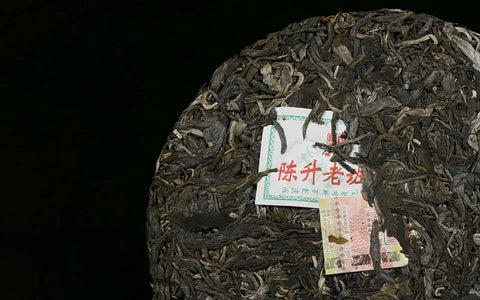
Bestsellers
The Ecological Environment of Lao Ban Zhang Ancient Tea Gardens
The excellent quality of Lao Ban Zhang tea is significant due to its location deep in the Bulang Mountain area of Menghai County, far from the city, and belonging to a very remote and pristine forested mountain area. The comprehensive three-dimensional ecological environment here is well preserved, which is very conducive to the growth of tea trees and the production of high-quality tea.

There is a saying “高山云雾出好茶“ in China, which means tea grown in high-altitude areas with thick mountain mist tends to have better quality than tea grown in lower-altitude areas with less mist. Lao Ban Zhang is located at an altitude of around 1,700 meters, with large temperature differences between day and night, suitable light intensity, and humidity creating a natural climate that is conducive to the growth of high-quality tea plants. The thick mountain mist also helps to protect the tea leaves from excessive exposure to direct sunlight, which can have a negative impact on their flavor and aroma.
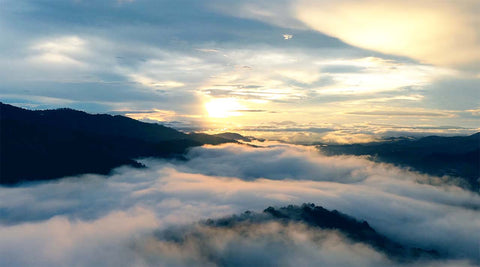
The location of the Lao Ban Zhang village has a diverse cultural preservation of the original ecological vegetation, rich organic matter in the soil, abundant sunshine, thick fog, and high humidity. It is particularly suitable for the growth of ancient tea trees. The soil in Lao Ban Zhang is slightly acidic red soil with a deep layer of organic and mineral substances, which promotes the formation of high-quality Lao Ban Zhang tea.
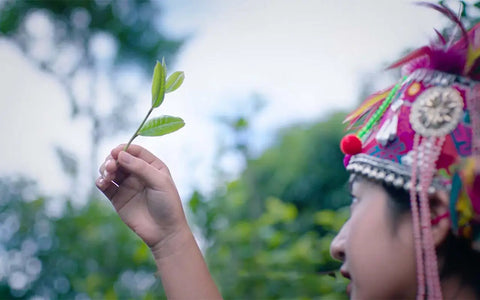
Since ancient times, the villagers of Lao Ban Zhang have followed traditional ancient methods to manually cultivate ancient tea trees, adhering to the folk custom of hand-picking fresh leaves and sun-drying them. Today, Lao Ban Zhang Pu-erh tea is one of the few tea-producing areas in Yunnan Province that does not use inorganic fertilizers, pesticides, and other chemicals. It is a pure, natural, pollution-free, and original ecological tea production area.
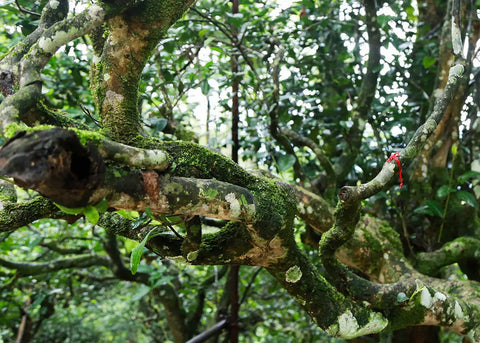
Burst of the Bubble in the Pu-erh Tea Market
In the spring of 2007, the Pu-erh tea market experienced a spectacular rise and fall in a short period of time, and many tea companies suffered losses. The price of Lao Ban Zhang rose to 1200 yuan per kilogram (USD$175) before plummeting to 400 yuan per kilogram (USD$58).
The speculation in the Pu-erh tea market can be divided into three stages. Before 2005, Hong Kong and Taiwan speculators were in control, buying up old tea and driving up the price of young tea. In the second stage, mainland distributors began ordering large quantities of tea from factories due to a shortage, reviving many dying tea fields in Yunnan. In the third stage, Hong Kong and Taiwan speculators began using auctions and other methods to further hype the market, leading to massive hoarding by distributors. This created a vicious cycle of chaos and disorder in the Pu-erh tea industry, with speculators creating concepts, hoarding chips, and driving up prices, only to abandon the market at the height of the bubble, leaving investors to suffer the consequences.
Lao Ban Zhang
The Story Between Lao Ban Zhang and Chen Sheng Hao
Against the backdrop of the high prices of Lao Ban Zhang Pu-erh tea, when many people hear the name Lao Ban Zhang, the first thing that may come to mind is Chen Shen Hao.
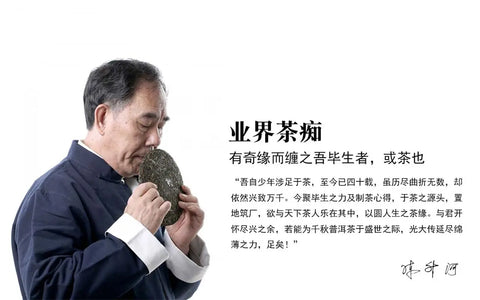
In 2007, Mr. Chen Shenghe (陈升河), the founder of Menghai Chen Sheng Tea Co. (勐海陈升茶厂), decided to settle in Menghai, Yunnan after several months of traveling and discovering this Pu-erh tea kingdom. Chen Sheng Hao is a Pu-erh tea brand under Menghai Chen Sheng Tea Co.

During the exploration, Mr. Chen Shenghe felt that Yunnan Pu-erh tea did not have a representative brand and that the production of tea by the people was not standardized. One day when he went to Ban Zhang village, he met with local villagers. During their conversation, the villagers expressed their hope that Mr. Chen Shenghe could take over Lao Ban Zhang, which was the wish of most of the villagers in Lao Ban Zhang.
In 2007, the Pu-erh tea market bubble burst, causing prices to fluctuate greatly and causing great harm to tea farmers’ income and life. As a corporate entity, Mr. Chen Shenghe felt a responsibility and obligation to protect tea farmers, maintain long-term stability of the market, and the creation of high-quality materials (Mao Cha) for the company.
After the bursting of the Pu-erh tea market bubble in 2007, Mr. Chen Shenghe spent millions of yuan to purchase more than 10,000 kilograms of tea that had been stockpiled by all tea farmers in Lao Ban Zhang. Under the leadership of the government, Lao Ban Zhang village began to seek a village-enterprise cooperation model. With the approval of the Menghai County People's Government and the consent of almost all Lao Ban Zhang villagers, the Menghai Chen Sheng Tea Co., Ltd. and Lao Ban Zhang village signed a 30-year cooperative purchasing and sales agreement for Lao Ban Zhang Pu-erh tea in 2008, jointly creating the "Chen Sheng Lao Ban Zhang" Pu-erh tea brand.
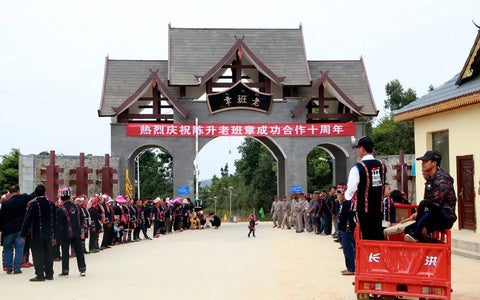
The agreement stipulated that in accordance with the principle of mutual benefit, the Lao Ban Zhang village group would provide land free of charge, and Chen Sheng Tea Co. would unilaterally invest in the construction of the "Menghai Chen Sheng Tea - Lao Ban Zhang Production Base" for the initial processing of Ban Zhang Pu-erh tea, and would have the exclusive legal sales rights to all Lao Ban Zhang Pu-erh tea produced by the Lao Ban Zhang village group in Bulang Mountain Township, Menghai County.
During the term of the agreement, the Lao Ban Zhang village group must sell all of its fresh leaves to the initial processing base for the whole year and ensure that no chemical fertilizers or pesticides are used. The price is determined by consultation between the two parties, with the market purchase price as a reference. It is a win-win situation that the villagers received stable income, and Chen Sheng Tea Co. also established its unique advantage.
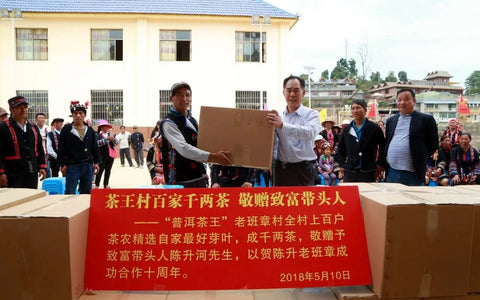
Cooperation is not just about money. During these years of cooperation, Chen Sheng Hao has spent a lot of effort in giving back to the local people. For example, donated funds to help Ban Zhang villages build roads, rebuild the third-generation Lao Ban Zhang village's Long Ba Gate (龙巴门), and invested in a medical station to solve the problem of difficulty seeking medical treatment for local villagers, etc.
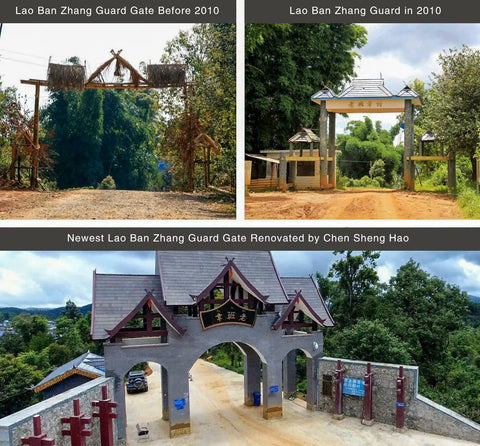

Chaos in Lao Ban Zhang
Lao Ban Zhang actually produces only about 40 tons of ancient tree tea per year, while various fake Lao Ban Zhang teas flood the market every year. In the past, some villagers in search of greater profits would smuggle nearby villages’ artificially cultivated tea from the Menghunba area to their homes and sell them as Lao Ban Zhang tea.
Chen Sheng Hao established a production base in Lao Ban Zhang village, where they can control the source of Lao Ban Zhang Pu-erh tea, and ensure stable quality. To protect the brand of Lao Ban Zhang, the village has specially formulated village rules and regulations, and villagers take turns guarding the village gate every day to prevent external tea from entering the village. The village committee organizes a supervisory team to monitor 24 hours a day, ensuring the purity of the origin of tea materials. This is an important aspect of the cooperation between the village and the enterprise to guarantee the quality of tea.
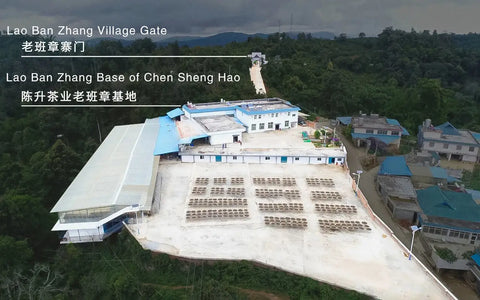
In addition, many Lao Ban Zhang tea farmers used to collect tea using bags that had been used to store fertilizer and other materials, which contaminated the tea leaves. They also had a habit of laying the tea leaves out on the ground to dry, which was unhygienic and poorly ventilated. The leaves on top would often become over-sun-dried, while the leaves at the bottom would still be damp. During rainy days, farmers would place the tea leaves near the fire to smoke them, which caused pollution to the fresh leaves. As for the tea processing method, there was no unified standard, and the quality of the collected tea leaves was uneven, which significantly affected the quality of materials.
Good materials alone do not guarantee good tea. From picking, withering, and drying to pressing and molding, each step determines the quality of Pu-erh tea. Without strict standards, how can it be called Lao Ban Zhang?
Chen Sheng Lao Ban Zhang initial processing base built a modernized withering shed covering an area of nearly 3000 square meters, as well as rooms for boiler, withering, pressing, drying, packaging, and storage. They greatly improved the production standards of Lao Ban Zhang Pu-erh tea.
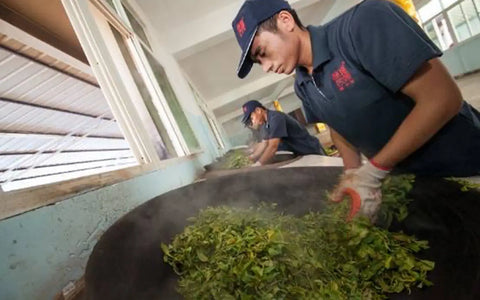
In response to the non-standard tea-picking behavior of tea farmers, Chen Sheng Hao customizes a double-layer moisture-proof woven bag for drying tea for every household in Lao Ban Zhang to replace the original chemical fertilizer bags. After the tea farmers deliver the fresh leaves to Chen Sheng Lao Ban Zhang initial processing base, they strictly check the quality of the freshly picked leaves, classify and weigh them, and immediately spread them evenly on bamboo mats for withering and subsequent processing in a clean and tidy withering field with multi-layer racks and fly and insect-proof measures.
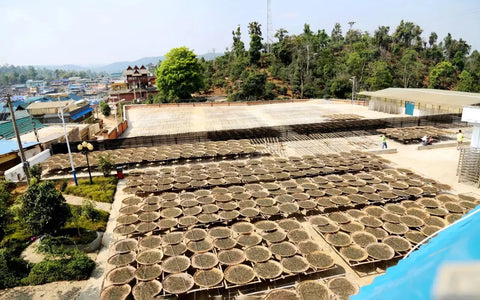

In order to protect the ancient tea trees, Chen Sheng Hao invited experts and scholars to go up the mountain to communicate with the tea farmers, guiding them to scientifically pluck the tea leaves and only harvest them twice a year. They also spread green pest control knowledge and donated insect traps and insecticidal lamps to be placed in the tea garden. Under such green pest control, the Lao Ban Zhang Pu'er tea can not only reduce the damage rate of tea buds, and stabilize production, but also not affect its natural ecology and health. Chen Sheng Hao wants the tea farmers to understand that only by scientifically protecting these tea trees, can they better promote Lao Ban Zhang tea to the world.
How to Distinguish Real Lao Ban Zhang Pu-erh tea?
Material
Lao Ban Zhang Pu-erh tea is made from the fresh large-leaved tea tree leaves from the ancient tea gardens in Lao Ban Zhang village. Chen Sheng Lao Ban Zhang selects single-origin materials from ancient trees aged more than 300, allowing tea lovers to taste the pure and true Lao Ban Zhang flavor.
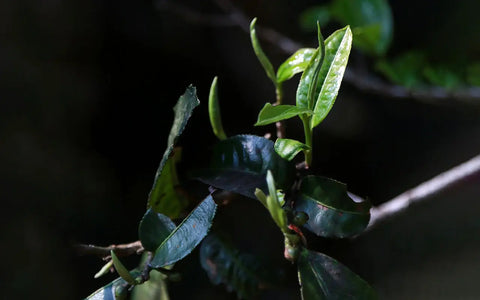
Appearance of Dried Leaves
The dry leaves have a lustrous dark green color, with coarse and hairy strips, relatively large serrated leaves, and plump buds with a lot of fuzz.
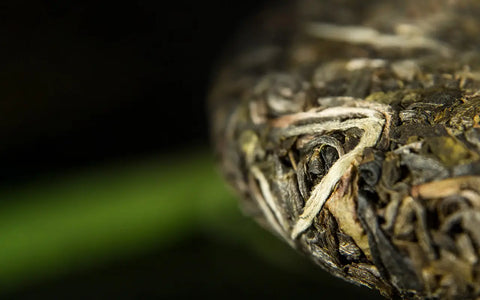
Aroma
Before prying the tea cake, you can smell the aroma. When the cotton paper that wraps the Lao Ban Zhang tea cake is opened, the woody aroma of the mountains will be evident.
The age of Lao Ban Zhang ancient tea trees is old, and their roots are deeply rooted. In the area of the Lao Ban Zhang ancient tea trees, it is not possible to dig out a piece of stone, and the soil is formed by the accumulation of fallen leaves year after year. This naturally formed soil structure creates the fragrance of Lao Ban Zhang ancient tree tea. The fragrance is a woody scent that comes from a distant era.
Aroma from the cup
The inherent fragrance of the Lao Ban Zhang tea will be left on the teacup.
At this point, when you lift the teacup to smell the cup aroma, the unique mountain and woody fragrance of the Lao Ban Zhang tea will drift out of the empty teacup, slowly turning into a honey and orchid fragrance. The tongue will reflect a slight sweet aftertaste.
In fact, smelling the tea fragrance is like feeling the charm of deep valley orchids. That kind of fragrance will come suddenly, slip through, and refresh the heart and soul. This kind of fragrance is an unforgettable eternity. Therefore, to smell the fragrance of Lao Ban Zhang tea, you need to have this kind of mentality.
Observing the soup color
After the second infusion of the Lao Ban Zhang tea, pour it into a fair cup to observe the soup color.
Color of the Lao Ban Zhang Pu-erh tea soup: There are different changes in the soup color in different years. The Lao Ban Zhang tea soup color stored within three years is golden, transparent and bright, and it gradually changes after natural aging. After three years, the golden color begins to turn yellow-red.
At this point, as long as the tea has been stored in a dry warehouse for less than five years, the soup color is generally golden and bright. For tea that has been stored for more than five years, the soup color begins to turn red. If it has been stored for a very long time, the soup color is even redder, not bright, but has a shiny and oily feeling. The liquid has a certain viscosity that creates mellow taste.
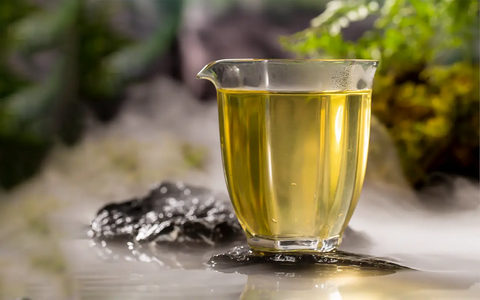
Tasting
When sipping Lao Ban Zhang tea, some people describe it as bitter and others as astringent. They all made the taste of "the King of tea”.
However, if the tea were only bitter and astringent, it wouldn't be a good tea. Lao Ban Zhang tea has a bitter taste with a hint of sweetness and an astringent taste with a lingering fragrance. After drinking the tea, the bitterness and astringency disappear instantly, leaving behind a sweet fragrance that lingers in the throat for a long time. Tea enthusiasts refer to this lingering fragrance in the throat as "throat rhyme (喉韵)," which is the sought-after "kingly" taste of Lao Ban Zhang tea.
Lao Ban Zhang gushu Pu-erh tea is particularly durable and spring tea can be brewed over twenty times. Spring tea is representative of Lao Ban Zhang tea's dominance.
Regarding the so-called " King of Tea" Lao Ban Zhang, no matter what era or region, the tea's king status has never been shaken. The main reason it is called "king" is because of the tea's instant dominance upon entering the mouth, powerful “chaqi” with a strong bitter taste and a good aftertaste.
“Chaqi (茶气)” creates a strong stimulation when drinking Lao Ban Zhang tea. Some people feel their hands, heads, and backs slightly sweating after drinking three cups. The stronger feeling may make people feel a rush of heat straight to their foreheads, causing their faces to turn red and ears to feel hot. The palms of their hands become red, and the lines of their hands become hazy in red color.
Infused Leaves
After brewing the tea over twenty times, pour the tea leaves onto a tea tray to observe its unique characteristics: the leaves are thick and plump, the buds are large, and there are obvious white hairs.
When picking up a complete tea leaf, you will feel that the surface of the leaf is as thin as a cicada's wings, extremely soft, and has a strong cottony texture. When pinched and rubbed with two fingers, you will find that the leaf has a particularly resilient texture that slides along with your fingertips, but the leaf will not break. If you wrap a complete tea stem around your fingers, it will feel like a resilient rubber band that is not easily broken.

How to Find a Reliable Source for Purchasing High-Quality Lao Ban Zhang Pu-erh Tea?
Chen Sheng Lao Ban Zhang tea is jointly guaranteed by three units: the Lao Ban Zhang Group of Ban Zhang Village Committee of Bulang Mountain Township, Menghai Chen Sheng Tea co., and the Lao Ban Zhang Tea Farmers Association of Bulang Township in Menghai County, which are stamped on cotton paper in the form of three red circular seals. These three seals have become the classic mark of Chen Sheng Lao Ban Zhang Pu-erh tea, indicating that every piece of Lao Ban Zhang tea is only allowed to be produced after being certified by these three units, and its quality is reliable!
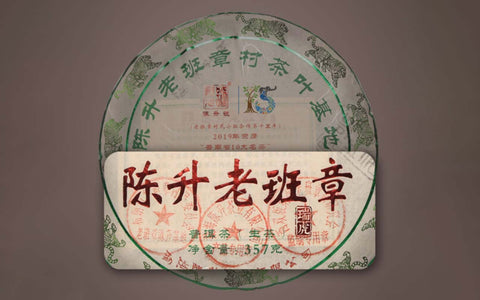
Tea review from TeaDB for 2022 CSH Lao Ban Zhang
← Older post Newer post →











